|
HDPE Pipe Helps Utah’s Dixie Region

Utah’s Washington
County, in the state’s
Dixie region, is a popular
haven for retirees and
recreational sports fanatics.
Who could blame them? The
beautiful red sandstone landscape,
easy drive to Las
Vegas, and moderate winter
temperatures all work together
to make the region one of
the United States’ fastest
growing communities.
However, a booming population
equates to more demand on water in an area that
receives little to no snowfall and approximately 11 inches
of rainfall per year. With such a premium on water, the
Washington County Water Conservancy District has turned
to high-density polyethylene (HDPE) pipe, for its leak-free
characteristics, durability, strength, flexibility and ease of
installation.
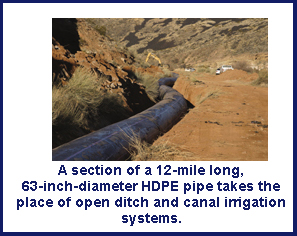 “We have been nothing but successful with HDPE pipe,”
said Chuck Carney, Operations Manager for the
Washington County Water Conservation District. “We’ve
been using it since 1986 and we’ve got it in all sizes from
1-inch to 63-inch.”
“We have been nothing but successful with HDPE pipe,”
said Chuck Carney, Operations Manager for the
Washington County Water Conservation District. “We’ve
been using it since 1986 and we’ve got it in all sizes from
1-inch to 63-inch.”
63-Inch Installation
In the fall of 2009, a new 1,400-foot, 63-inch IPS SDR
17 pipeline was installed, getting more water to a treatment
plant that provides Saint George and the suburban
areas of Washington, Ivins, Hurricane and Santa Clara with
water services.
Two reservoirs provide the water to sustain life in
Washington County – Quail Creek and Sand Hollow. The two
bodies of water are separated by the Virgin River, requiring
any pipelining created between the two reservoirs to be located
under the river bottom.
Previously, a steel
pipeline ran from Sand
Hollow to a hydroelectric
plant. From that plant,
another water line ran
into Quail Creek with a
bypass line tied in just
before the pipes
entrance to Quail Creek.
The bypass line supplies
water to the water treatment
plant that makes it
suitable for the public.
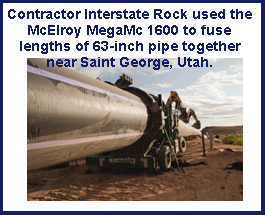
“We chose HDPE
because we had to go
under the river. We
have a 54-inch steel
line that forces us to
sleep with one eye
open,” said Carney. “We
wanted to put HDPE in
and not worry about a
leak or corrosion.”
The goal of the new HDPE
line is to get the water from
Sand Hollow directly to the
water treatment plant without
taking a longer route to the
hydroelectric plant and then
onward to Quail Creek. This
circumvention of the line
allows the water district to
simultaneously perform both
actions; running water from
the hydroelectric plant to
Quail Creek, and running water from Sand Hollow to the
water treatment plant. The ability to get increased water
resources to the water treatment plant is critical as the 40
million gallons-a-day plant looks to double output for the
booming population over coming years.
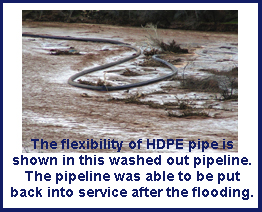 The installation
of the
pipe required
contractor
Interstate
Rock to divert
the Virgin
River between
the two reservoirs
in order
to lay the pipe
underneath
the riverbed.
After laying
the pipe, the
river was allowed to flow along its natural boundaries once
more. The entire length of pipe was installed with open
trench methods.
The installation
of the
pipe required
contractor
Interstate
Rock to divert
the Virgin
River between
the two reservoirs
in order
to lay the pipe
underneath
the riverbed.
After laying
the pipe, the
river was allowed to flow along its natural boundaries once
more. The entire length of pipe was installed with open
trench methods.
The large sticks of 63-inch-diameter HDPE pipe were
manufactured by PolyPipe and provided by High Country
Fusion, while the MegaMc® 1600 four-jaw fusion machine
used in joining the pipe was provided by ISCO Industries.
Local contractor, Interstate Rock, performed the pipeline
fusion and installation.
Pipe fusion is a widely accepted process that joins two
pieces of thermoplastic pipe together with heat and pressure.
Commonly associated with HDPE, the butt fusion
process starts by “facing” or shaving the pipe ends simultaneously
so that they can be joined together with heat to create
a continuous, sealed pipeline. The welding of the pipes
is accomplished by using a hot plate in contact with the pipe
ends, which heats the plastic to a molten state. Then, after
its removal, the pipe ends are pressed together under a controlled
force to form a weld that is as strong as or stronger
than the pipe itself. Third-party industry research indicates
that HDPE pipe and joints can have a lifespan of more than
100 years.
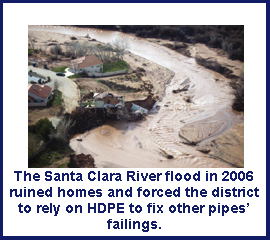 The McElroy MegaMc 1600 uses 30,000 pounds of
clamping force per jaw and 88,000 pounds of available
fusion force, extremely useful when dealing with such large, heavy pipe.
The drag forces
and characteristics
of this pipe
required
McElroy’s largest
fusion machine
to perform the
operations.
Washington
County has successfully
turned
to HDPE in previous
years.
The McElroy MegaMc 1600 uses 30,000 pounds of
clamping force per jaw and 88,000 pounds of available
fusion force, extremely useful when dealing with such large, heavy pipe.
The drag forces
and characteristics
of this pipe
required
McElroy’s largest
fusion machine
to perform the
operations.
Washington
County has successfully
turned
to HDPE in previous
years.
Three Past HDPE Experiences
While the Washington County Water Conservation
District has had HDPE in use for more than 20 years with
numerous projects, three pipelines really standout in
showing what the pipe can do for a district.
The water district is responsible for irrigation lines to
farmers in the region. The irrigation was originally an
open canal and ditch system that resulted in water losses
due to leakage
and evaporation.
The unreliable
water supply
would cause outages
that were
expensive repairs
and took away
critical water
resources from
farmers when
they needed
them. The HDPE
solution was to
create a 12-mile-long pipeline consisting of 54- and 63-
inch pipe with 16-inch connections for each farmer. By
using the pipeline over the open canal, the district was
able to eliminate the troublesome problem of the canal
“sliding” off the
hillside.
HDPE also
showed its mettle
for Washington
County during a
100-year-flood
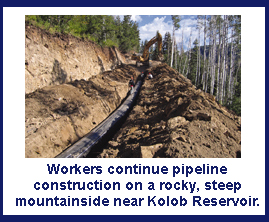 event in 2006.
The Santa Clara
River flooded
after heavy snow
and rains, washing
out a 28-inch
HDPE irrigation
line. Carney reports that the HDPE line was never
breached and all the fusion joints were intact, even after
repeated contact with trees, boats, rocks and other flood
debris.
event in 2006.
The Santa Clara
River flooded
after heavy snow
and rains, washing
out a 28-inch
HDPE irrigation
line. Carney reports that the HDPE line was never
breached and all the fusion joints were intact, even after
repeated contact with trees, boats, rocks and other flood
debris.
The worst damage
done to the
28-inch line was
caused by the
contractor,
pulling it from
the river. The
retrieved HDPE
pipe was sorted
out, fused back
together and put
back into service.
“The durability of
the pipe continues
to impress us,” said Carney. “No other type of pipe
could have withstood the battering this pipe received and
remained intact.”
For another water conservation measure, Washington
County took to the mountains to create a 12-mile line of
36-inch HDPE
pipe. The line was
built to ensure
that Kolob
Reservoir would
be full each year
for downstream
irrigators’ use.
The reservoir’s
 main water
source was mountain
snow melt,
and the pipeline
stretched from a 9,500’ elevation down to the 8,000’ elevation
height of the reservoir. This design allowed the pipe
to capture the water at the source. By making this water
capture so effective, it guaranteed that the reservoir
would fill every year, even in years with minimal snowfall.
main water
source was mountain
snow melt,
and the pipeline
stretched from a 9,500’ elevation down to the 8,000’ elevation
height of the reservoir. This design allowed the pipe
to capture the water at the source. By making this water
capture so effective, it guaranteed that the reservoir
would fill every year, even in years with minimal snowfall.
The environment for the pipeline was demanding,
requiring the HDPE to traverse rocky terrain with steep
slopes and corrosive soils. Prone to landslides, engineers
chose HDPE for flexibility and strength when soil movement
occurs. Because of the life span of the pipe, workers
won’t have to repair or replace the pipe in areas with no
road access.
Advice
Carney advises municipalities that there is some trade
off when you use HDPE. He believes the confusion
between inner and outer diameters of HDPE compared to
other pipe materials frustrates municipalities that don’t
fully understand all the benefits.
“A lot of communities don’t want to spend more to upsize
to get the same size inner diameter they would with PVC or
ductile iron. I tell them, ‘when you’re up at midnight digging
that up and fixing it, I’m at home sleeping easy.’”
Written by Tyler Henning, McElroy Manufacturing, Inc.,
833 N. Fulton Ave., Tulsa, OK 74115, 918-831-9286,
E-mail: thenning@mcelroy.com, Web: www.mcelroy.com.
|